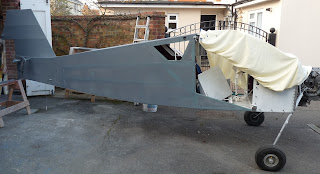
Today it was time to glue the first of the lower wing skins into place. First job was to cut the 4-1/2" x 8' piece of ply cut off yesterday into 8 strips using the bandsaw. 4 of these will be used to staple the skin onto the two spars and leading and trailing edges of the wing. The rest will be cut up and used to staple the skin to the ribs.
A batch of West Systems Epoxy was made up with the slow 206 hardener. Even with the slow hardener the epoxy reaction is exothermic and in the confines of the mixing cup can get hot and gel quickly, so enough was made in the first batch to coat inside the lines marked on the skin itself.

Once the glue is spread out the working time is considerably extended so another batch was then made up to coat the wing structure itself.
The wing was first placed on the bench upside down and once all the glue was applied the skin was slotted over the strut attach brackets and into place. Working from the middle out the skin was then stapled onto the main spar. Then, again from the middle out, the skin was stapled to the ribs between the two spars. Next the skin was stapled to the rear spar and then the rearmost section of ribs and the trailing edge.
This process was repeated with the front section of ribs and the leading edge with the exception of the innermost stub rib. As the curve of the skin is greater at the front, clamps were also used to ensure the staples would hold. The wing was then turned over to check that the joints looked properly glued and clamped.

Then the skin was clamped onto the innermost stub rib. This is easy enough behind the main spar but in front of it there is a significant bend in the skin. Multiple clamps were
required to hold the skin to the tapered section of the main spar and to the stub rib itself as staples did not have enough holding capability. The front section of skin was also painted with epoxy which when fully set should help it to hold shape and reduce the stress on the glue joint. I think I will also install some fillets of wood in the joint before closing up the wing.
Next job a full 24 hours for the epoxy to set.
 The picture shows the left wing after the clamps were removed and the wing turned upside down. I'm going to leave the stapling strips on until eveything is finished to provide a bit of protection to the wing skin. There are a lot of staples to be removed !
The picture shows the left wing after the clamps were removed and the wing turned upside down. I'm going to leave the stapling strips on until eveything is finished to provide a bit of protection to the wing skin. There are a lot of staples to be removed !









 .
. 

